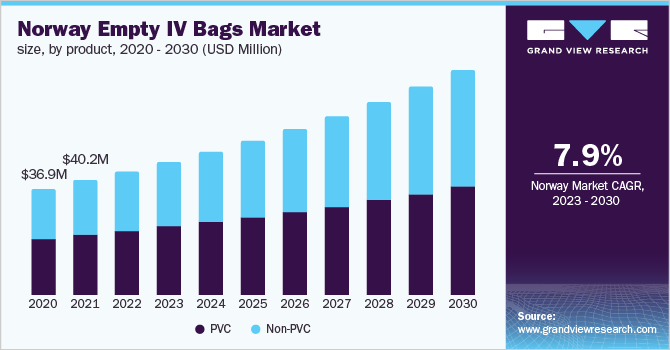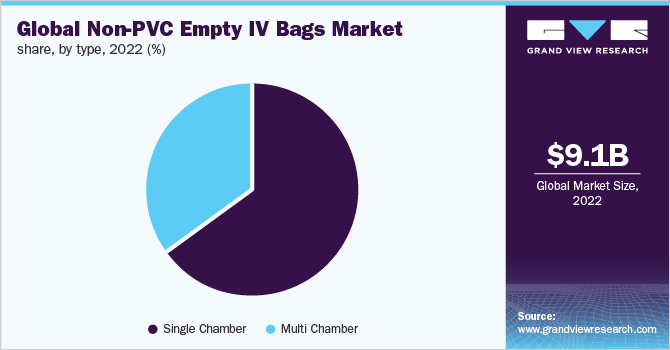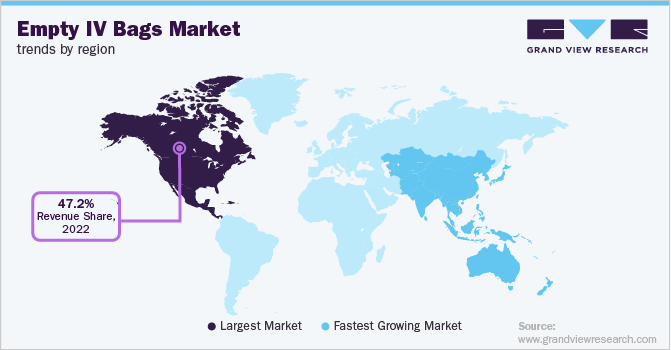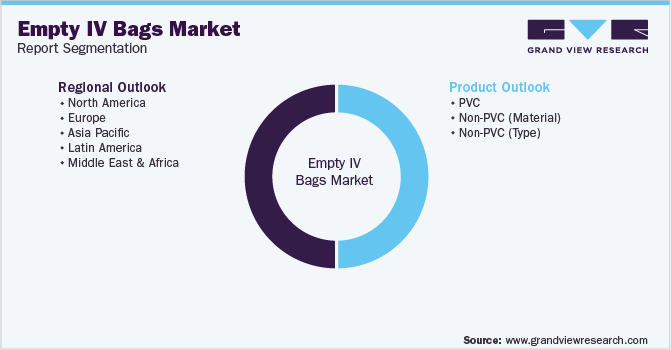- Home
- »
- Medical Devices
- »
-
Empty IV Bags Market Size, Share & Growth Report, 2030GVR Report cover
![Empty IV Bags Market Size, Share & Trends Report]()
Empty IV Bags Market Size, Share & Trends Analysis Report By Product (PVC, Non-PVC), By Region (North America, Europe, Asia Pacific, Latin America, Middle East & Africa), And Segment Forecasts, 2023 - 2030
- Report ID: GVR-3-68038-494-9
- Number of Pages: 110
- Format: Electronic (PDF)
- Historical Range: 2018 - 2021
- Industry: Healthcare
Report Overview
The global empty IV bags market size was valued at USD 4.54 billion in 2022 and is expected to expand at a compound annual growth rate (CAGR) of 8.60% from 2023 to 2030. The growth of the empty IV bags industry is attributed to technological advancements, the increasing prevalence of chronic conditions, the impact of COVID-19, and the growing risk of malnutrition. The COVID-19 pandemic has created a number of challenges for the healthcare industry worldwide. Restricted access to medical services has led to inadequate medical facilities for patients suffering from various conditions. However, the increase in hospital admission rates due to COVID-19 has led to a rise in the demand for intravenous bags used in IV therapy across all hospital settings globally. Hence, the market is expected to witness significant and continuous growth even after the pandemic ends.

The use of intravenous fluid treatment for COVID-19 patients in need was advised in interim guidelines that were issued by a number of organizations including the WHO, CDC, and NIH. Similarly, recommendations made by the U.K. Joint Anaesthetic and Intensive Care and International Fluid Academy recommended administering fluid therapy to critically ill patients to address their fluid and electrolyte needs.
As a result, these recommendations are helping to drive up the price of empty IV bags during the pandemic. Additionally, for patients who are COVID-19 positive, the European Society for Clinical Nutrition and Metabolism (ESPEN) is advocating the use of enteral and parenteral nutrition to meet their daily nutritional needs. The need for IV fluids is anticipated to increase dramatically as a result of these recommendations from numerous organizations, which will also increase demand for empty intravenous (IV) bags.
Significant research in the medical field has concluded that PVC-made empty intravenous bags are hazardous to human health and the environment due to phthalates leaching from equipment. In addition, the disposal of PVC products through the incineration process results in the production of toxic Hydrogen Chloride (HCL). This further contributes to acid rain.
Hence, companies such as Baxter, Hospira, and B. Braun Melsungen AG are manufacturing IV bags made of PVC-free material, which has thermal stability, moisture-barrier properties, inertness required for IV medications, and are environment friendly. For instance, Hospira launched the VISIV line of PVC/DEHP-free IV bags that have no overwrap, thereby reducing the amount of plastic that has to be discarded.
PVC-free empty IV bags are usually made of Ethylene-Vinyl Acetate (EVA), multilayer polyethylene, or polypropylene, which are compatible with the drug solution and have high seal strength. Pactiv LLC manufactures polypropylene-based bags, known as Propyflex bags, which have won the 2000 Medical Design Excellence Award in a program sponsored by Canon Communications LLC.
In addition, several firms are turning to plasticizer-free biologically inert materials to substitute the use of PVC. In the past five years, B. Braun spent around USD 500.00 million developing PVC- and DEHP-free products. The development and availability of modern materials in different designs are expected to boost growth through the replacement of glass & PVC containers.
Similarly, in March 2021, Fagron Sterile Services U.S. (FSS), a 503B outsourcing leader, announced the addition of a new platform, Intravenous (IV) bags, to its product portfolio. Hence, with the adoption of PVC-free empty IV bags, the healthcare industry can make significant progress in protecting the health and safety of the patient population globally. Such factors are anticipated to drive the adoption of non-PVC empty IV bags, thereby contributing to the growth of the market.
The increasing prevalence of chronic conditions, such as cancer, positively impacts the use of parenteral nutrition across the country. Parenteral nutrition helps in the administration of vital nutrients, which help in maintaining strength, energy, and hydration level in patients suffering from a disease.
According to statistics published by WHO, nearly 10 million people will die from cancer worldwide in 2020, making it the top cause of death. Moreover, the prevalence of cancer is estimated to increase by 70.0% over the next couple of decades. Thus, the increasing prevalence of cancer globally is a high-impact-rendering driver for the empty IV bags market growth.
Product Insights
The PVC empty IV bags led the market and accounted for more than 50.21% share of the global revenue in 2022. PVC is one of the main polymers used in the fabrication of films for flexible parenteral packages. It is a popular material as it has a number of useful technical properties, is comparatively cheap to manufacture, and is easy to work with. For instance, according to a report by the European Union that was released in 2020, PVC is the fourth most popular form of plastic in Europe, and about 6.5 million T of PVC products are produced each year.
In addition, PVC empty IV bags find extensive application in the packaging of rehydration solutions that comprise sodium chloride, lactated Ringer’s solution, glucose, sterile water, parenteral nutrition, antibiotics & analgesics for hospital and veterinary usage, among others. Moreover, a large number of key market players such as RENOLIT SE and Technoflex offer PVC empty IV bags. Thus, owing to such factors the segment dominated the market in 2020.

The non-PVC empty IV bags segment is expected to expand at the highest CAGR during the forecast period. Demand for non-PVC material is likely to increase owing to rising demand for non-toxic IV containers and stringent legislation prohibiting the use of PVC. These bags help reduce the risks associated with traditional PVC empty IV bags, such as transportation difficulties, and the interaction between drug-packaging material, and disposable containers. These materials can be used for a variety of applications, including cold or frozen storage and customized mixtures. As a result, the broad application of non-PVC empty IV bags is projected to drive market expansion over the projection period.
In addition, regulatory agencies such as the U.S. FDA have advocated for the use of packaging that is free of di-2-Ethylhexyl phthalate (DEHP). DEHP is reported to be incompatible with certain devices. Thereby, market players at present are inventing IV bags made of materials such as Ethyl Vinyl Acetate (EVA), Polypropylene, Copolyester-Ether (COPE), and others.
The non-PVC empty IV bags segment has been segmented into single and multi-chambered bags. Two and three-chamber empty IV bags are included in the section of multi-chambered bags. In 2022, the single-chambered bag category accounted for the largest market share. Numerous factors, including high usage and a lack of alternatives, are anticipated to fuel category growth during the forecast period. The existence of separate storage for various components is likely to increase the demand for multi-chambered bags. Consequently, during the projected period, the segment is anticipated to develop at the fastest rate.
Regional Insights
North America dominated the market with the largest revenue share of over 47.20% in 2022. The ease of access to healthcare technologies and the presence of strong distribution channels are among the factors contributing to the increasing adoption of empty IV bags in the region. High disease prevalence, supportive reimbursement policies, and a well-defined regulatory framework are further expected to boost the adoption of empty IV bags in the region.
In addition, factors such as higher healthcare expenditure and rapid adoption of safe IV solutions are boosting the market in the country. Moreover, the country is anticipated to witness an increase in the adoption of non-PVC bags due to various benefits offered by these products such as easy recycling and availability of cost-effective alternatives such as the presence of softeners.

An increasing number of people suffering from chronic conditions, such as cancer, gastrointestinal disease, and others, has led to the need for empty IV bags in healthcare settings. Moreover, demand for empty IV bags has increased in the country due to the high prevalence of stomach cancer. For instance, the American Cancer Society estimated that in 2021 there were about 26,560 new cases of stomach cancer, which accounts for about 1.5% of all new cancer cases diagnosed each year.
Patients suffering from stomach cancer are incapable of ingesting food through the mouth and thus have to entirely rely on total parenteral solutions for dietary needs and survival. This might surge the demand for empty IV bags, which, in turn, is expected to boost regional market growth.
Asia Pacific is anticipated to witness the fastest growth over the forecast period, owing to increasing healthcare expenditure, rising patient awareness, and a growing need for technologically advanced & cost-efficient healthcare solutions. Moreover, the rising elderly population and subsequently growing burden of chronic diseases are expected to boost the demand for empty IV bags in the Asia Pacific in the coming years.
As per United Nations Sexual and Reproductive Health Agency (UNFPA) report, the aging population in the APAC region is rising at an unprecedented rate and by 2050, one in four people in this region will be over 60 years, reaching close to 1.3 billion people. It was also reported that cardiovascular diseases, diabetes, and cancer are the most common diseases in this region. The presence of a large patient base and growing need for technologically advanced & cost-efficient healthcare solutions is expected to present significant regional growth opportunities for the market.
Key Companies & Market Share Insights
Manufacturers of empty IV bags are working more quickly to obtain licenses for their products so that mass production may start. Additionally, the market participants are utilizing a variety of tactics, including partnerships, product launches, product releases, and innovations like the development of empty IV bags products, to improve their position in the market.
For instance, in January 2022, the U.S. FDA has given its final permission to B. Braun Medical Inc. (B. Braun) for the company's new pharmaceutical production facility in Daytona Beach, Florida. The facility will produce 500 mL and 1,000 mL Excel Plus IV Bags with 0.9% Sodium Chloride for Injection from B. Braun. The Excel Plus IV bags are created without DEHP, PVC, or natural rubber latex in keeping with B. Braun's long-standing commitment to safeguarding patients from exposure to hazardous chemicals. Moreover, in April 2021, Winpak and Wipak joined forces to form a new global brand Wiicare for healthcare packaging solutions. The strategy helped the company strengthen its market position. Some prominent players in the global empty IV bags market include:
-
Baxter
-
B. Braun Medical Inc.
-
ICU MEDICAL, INC.
-
Wipak
-
RENOLIT SE
-
TECHNOFLEX
-
Sippex IV bags
-
JW Life science Corp
-
Fresenius Kabi AG
-
POLYCINE GmbH
-
BAUSCH Advanced Technology Group
-
BD
Empty IV Bags Market Report Scope
Report Attribute
Details
Market size value in 2023
USD 4918.10 million
Revenue forecast in 2030
USD 8.76 billion
Growth Rate
CAGR of 8.60% from 2023 to 2030
Base year for estimation
2022
Historical data
2018 - 2021
Forecast period
2023 - 2030
Quantitative units
Revenue in USD million and CAGR from 2023 to 2030
Report coverage
Revenue forecast, company ranking, competitive landscape, growth factors, and trends
Segments covered
Product, region
Regional scope
North America; Europe; Asia Pacific; Latin America; MEA
Country scope
U.S.; Canada; U.K.; Germany; France; Italy; Spain; Denmark; Sweden; Norway; Japan; China; India; Australia; Thailand; South Korea;Brazil; Mexico; Argentina; South Africa; Saudi Arabia; UAE; Kuwait
Key companies profiled
Baxter; B. Braun Medical Inc.; ICU MEDICAL, INC.; Wipak; RENOLIT SE; TECHNOFLEX; Sippex IV bags; JW Life science Corp; Fresenius Kabi AG; POLYCINE GmbH; BAUSCH Advanced Technology Group; BD
Customization scope
Free report customization (equivalent up to 8 analysts working days) with purchase. Addition or alteration to country, regional & segment scope
Pricing and purchase options
Avail customized purchase options to meet your exact research needs. Explore purchase options
Global Empty IV Bags Market Segmentation
This report forecasts revenue growth at the global, regional, and country levels and provides an analysis of the latest industry trends in each of the sub-segments from 2018 to 2030. For this study, Grand View Research has segmented the global empty IV bags market report based on product and region:

-
Product Outlook (Revenue, USD Million, 2018 - 2030)
-
PVC
-
Non-PVC (Material)
-
Polypropylene
-
Copolyester ether
-
Ethylene-vinyl acetate
-
Others
-
-
Non-PVC (Type)
-
Single Chamber
-
Multi Chamber
-
-
-
Regional Outlook (Revenue, USD Million, 2018 - 2030)
-
North America
-
U.S.
-
Canada
-
-
Europe
-
U.K.
-
Germany
-
France
-
Italy
-
Spain
-
Denmark
-
Sweden
-
Norway
-
Rest of Europe
-
-
Asia Pacific
-
Japan
-
China
-
India
-
Australia
-
Thailand
-
South Korea
-
Rest of APAC
-
-
Latin America
-
Brazil
-
Mexico
-
Argentina
-
Rest of LATAM
-
-
Middle East and Africa (MEA)
-
South Africa
-
Saudi Arabia
-
UAE
-
Kuwait
-
Rest of MEA
-
-
Frequently Asked Questions About This Report
b. The global empty IV bags market size was estimated at USD 4,545.38 million in 2022 and is expected to reach USD 4,545.38 million in 2023.
b. The global empty IV bags market is expected to grow at a compound annual growth rate of 8.60% from 2023 to 2030 to reach USD 8.76 billion by 2030.
b. North America dominated the empty IV bags market with a share of 47.20% in 2022. This is attributable to rising acceptance of innovative healthcare technologies, better reimbursement policies, and increasing investments for improving healthcare infrastructure.
b. Some key players operating in the empty IV bags market include Baxter, B. Braun Medical Inc., ICU MEDICAL, INC., Wipak, RENOLIT SE, TECHNOFLEX, Sippex IV bags, JW Life science Corp, Fresenius Kabi AG, POLYCINE GmbH, BAUSCH Advanced Technology Group, BD.
b. Key factors that are driving the market growth include environment-friendly nature of non-PVC IV bags, increasing government initiatives, risk of malnutrition, and increasing incidence of cancer across the globe.
Share this report with your colleague or friend.
![gvr icn]()
NEED A CUSTOM REPORT?
We can customize every report - free of charge - including purchasing stand-alone sections or country-level reports, as well as offer affordable discounts for start-ups & universities. Contact us now
![Certified Icon]()
We are GDPR and CCPA compliant! Your transaction & personal information is safe and secure. For more details, please read our privacy policy.
We are committed towards customer satisfaction, and quality service.
"The quality of research they have done for us has been excellent."





